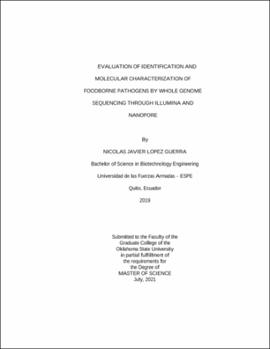| dc.contributor.advisor | Ma, Li Maria | |
| dc.contributor.author | Lopez Guerra, Nicolas Javier | |
| dc.date.accessioned | 2022-01-21T19:33:49Z | |
| dc.date.available | 2022-01-21T19:33:49Z | |
| dc.date.issued | 2021-07 | |
| dc.identifier.uri | https://hdl.handle.net/11244/333814 | |
| dc.description.abstract | As next-generation sequencing (NGS) costs has dropped in recent years, whole genome sequencing (WGS) has been adopted as the primary typing method for pathogens of interest in outbreak surveillance in the U.S. In this study, we aimed to evaluate the performance of Nanopore sequencing for rapid identification and molecular characterization of E. coli and Salmonella, two major foodborne bacterial pathogens. Eleven E. coli and ten Salmonella isolates obtained from pecan orchards were sequenced using MinION and Illumina NextSeq 500. As MinION allows real-time reads analysis, the reads were time-based subsampled to determine the earliest identification turnaround time for each isolate. Species level identification was achieved at 15 mins of sequencing run. Complete antigenic profile and variants of major virulence genes were detected in 16 and 25 hours using assemblies obtained from the subsampled-reads of E. coli and Salmonella, respectively. Additionally, comparisons of the Nanopore-based assemblies against hybrid assemblies from the combined reads of MinION and Illumina showed that the best values of continuity were obtained at 4 and 8 hours; whereas, the best value of annotated features were obtained in 16 and 25 hours for E. coli and Salmonella, respectively (p < 0.05). By using these assemblies as input in a stringent BLASTn search (percentage of identity of 95 % and query coverage of 85 %) against the Comprehensive Antibiotic Resistance Database (CARD), we could find significantly similar results to those obtained from the hybrid assemblies of Salmonella but not for E. coli isolates. However, the hits obtained from the search against the Virulence Factor Database (VFDB) were not sufficient to generate results significantly similar for both species. Finally, the results of phylogeny analysis obtained from assemblies created with reads produced in 3 hours of sequencing process from both species, were significantly similar to those of the results with hybrid genomes (p < 0.05). These results demonstrated that Nanopore can offer an effective sequencing platform for the rapid identification of E. coli and Nontyphoidal Salmonella isolates, with certain capabilities for their molecular characterization. | |
| dc.format | application/pdf | |
| dc.language | en_US | |
| dc.rights | Copyright is held by the author who has granted the Oklahoma State University Library the non-exclusive right to share this material in its institutional repository. Contact Digital Library Services at lib-dls@okstate.edu or 405-744-9161 for the permission policy on the use, reproduction or distribution of this material. | |
| dc.title | Evaluation of identification and molecular characterization of foodborne pathogens by whole genome sequencing through Illumina and Nanopore | |
| dc.contributor.committeeMember | Muriana, Peter | |
| dc.contributor.committeeMember | Espindola, Andres | |
| osu.filename | Lopez_okstate_0664M_17369.pdf | |
| osu.accesstype | Open Access | |
| dc.type.genre | Thesis | |
| dc.type.material | Text | |
| dc.subject.keywords | genomics | |
| dc.subject.keywords | nanopore | |
| dc.subject.keywords | outbreak | |
| thesis.degree.discipline | Food Science | |
| thesis.degree.grantor | Oklahoma State University | |
